alex00
Well-known member
After about a year trying to decide which inverter to go with I pulled the trigger on a Magnum MS2012. I found a great price online and ordered the remote to go with it. I ordered a complete solar system to go along with this, but haven't installed it yet.
The first step was deciding what type of sub panel. I went with the progressive dynamics PD5500 that splits the main AC panel. It's identical to the oem panel so wire length and panel placement are not an issue.
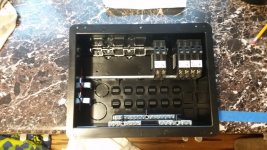
I had to pull out all my wires and label them. I found the factory mislabeled several circuits. It was easy enough to figure out with outlets but they switched the converter and washer dryer labels. I didn't figure that out until after wiring up the sub panel.
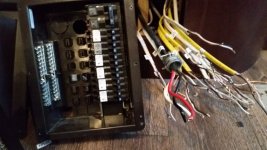
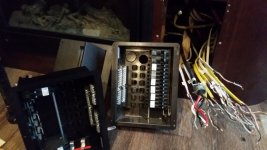
While I had the AC panel out I rewired my air conditioner switch. I added a breaker and ran 12/2 romex to the switch location. Once connected I covered it with a blank plate and eliminated the switch. Now I can run any two air conditioners at once.
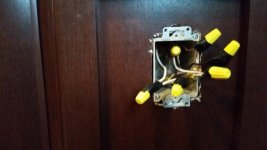

I wired the main AC panel to the sub panel without the inverter at first. I'm so glad I did this step to check my work. I had to buy a new 50 amp main breaker. The oem breaker was sacrificed during the disassembly. I had it all wired up and went to test. To my horror nothing worked right. I had power to one air conditioner and the garage outlet. Nothing else worked. My trouble shooting was hampered by a mislabeled breaker I didn't catch. The garage and vacuum circuits were reversed. I couldn't figure out why only the garage was working off the sub panel. Turns out it wasn't. After a few steps I realized a hot leg wasn't getting power. The inverter and an air conditioner were on this leg. Moving breakers around powered them up. A quick continuity test on the brand new main breaker showed one side wasn't working. A new-new breaker solved my problem.
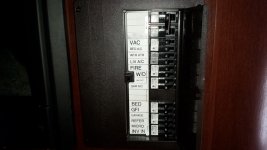
I used slotted angle cut to length and 5/16" carriage bolts to mount my inverter to the aluminum floor joists above my basement. The spacing of the joists and the placement of the slotted holes lined up perfectly with the mounting holes in the inverter. I dropped one inch carriage bolts in the appropriate holes and mounted the brackets using three bolts per bracket. The carriage bolts were great because they mated to the slotted angle well so I didn't have to worry about getting a wrench on both sides. It was pretty rough crawling into the basement and pushing the inverter up into place.

I split the wire I used to power my sub panel from the main panel and connected the inverter to both panels. I drilled a 2 1/2" hole between the battery compartment and basement to run wired. I had a pvc grommet in place but the 4/0 battery wires push it out of place. With a battery connected I did the function test and it was all correct.
Before buttoning everything up I fished the wires for my trimetric 2030 and the inverter remote into the panel above my switches. The holes came out sloppy for the monitors since my jigsaw wouldn't fit on the small panel.
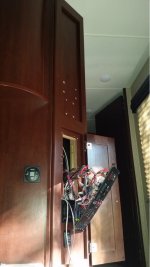
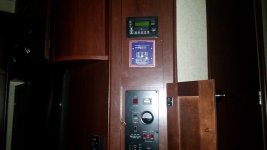
Unfortunately one of my battery cables was on back order so I can't install my 4 Trojan t105s yet. I'm just using the stock battery for all the testing. I built a battery box and coated it with bed liner. It's a simple wooden box with threaded pvc fittings on the the top and bottom for venting. I think I used 1 1/4 pvc fittings to mate up to the stock hose. I resorted to making my own since I couldn't find a sealed box that fit in my battery compartment.
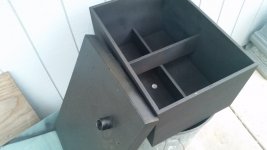
Hopefully I'll have time to install my solar in the next few days.
Sent from my iPad using Tapatalk
The first step was deciding what type of sub panel. I went with the progressive dynamics PD5500 that splits the main AC panel. It's identical to the oem panel so wire length and panel placement are not an issue.

I had to pull out all my wires and label them. I found the factory mislabeled several circuits. It was easy enough to figure out with outlets but they switched the converter and washer dryer labels. I didn't figure that out until after wiring up the sub panel.


While I had the AC panel out I rewired my air conditioner switch. I added a breaker and ran 12/2 romex to the switch location. Once connected I covered it with a blank plate and eliminated the switch. Now I can run any two air conditioners at once.


I wired the main AC panel to the sub panel without the inverter at first. I'm so glad I did this step to check my work. I had to buy a new 50 amp main breaker. The oem breaker was sacrificed during the disassembly. I had it all wired up and went to test. To my horror nothing worked right. I had power to one air conditioner and the garage outlet. Nothing else worked. My trouble shooting was hampered by a mislabeled breaker I didn't catch. The garage and vacuum circuits were reversed. I couldn't figure out why only the garage was working off the sub panel. Turns out it wasn't. After a few steps I realized a hot leg wasn't getting power. The inverter and an air conditioner were on this leg. Moving breakers around powered them up. A quick continuity test on the brand new main breaker showed one side wasn't working. A new-new breaker solved my problem.

I used slotted angle cut to length and 5/16" carriage bolts to mount my inverter to the aluminum floor joists above my basement. The spacing of the joists and the placement of the slotted holes lined up perfectly with the mounting holes in the inverter. I dropped one inch carriage bolts in the appropriate holes and mounted the brackets using three bolts per bracket. The carriage bolts were great because they mated to the slotted angle well so I didn't have to worry about getting a wrench on both sides. It was pretty rough crawling into the basement and pushing the inverter up into place.

I split the wire I used to power my sub panel from the main panel and connected the inverter to both panels. I drilled a 2 1/2" hole between the battery compartment and basement to run wired. I had a pvc grommet in place but the 4/0 battery wires push it out of place. With a battery connected I did the function test and it was all correct.
Before buttoning everything up I fished the wires for my trimetric 2030 and the inverter remote into the panel above my switches. The holes came out sloppy for the monitors since my jigsaw wouldn't fit on the small panel.


Unfortunately one of my battery cables was on back order so I can't install my 4 Trojan t105s yet. I'm just using the stock battery for all the testing. I built a battery box and coated it with bed liner. It's a simple wooden box with threaded pvc fittings on the the top and bottom for venting. I think I used 1 1/4 pvc fittings to mate up to the stock hose. I resorted to making my own since I couldn't find a sealed box that fit in my battery compartment.

Hopefully I'll have time to install my solar in the next few days.
Sent from my iPad using Tapatalk
